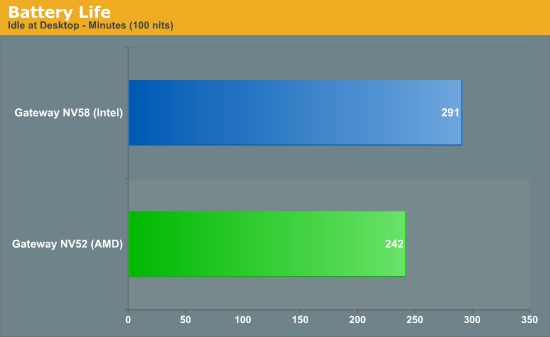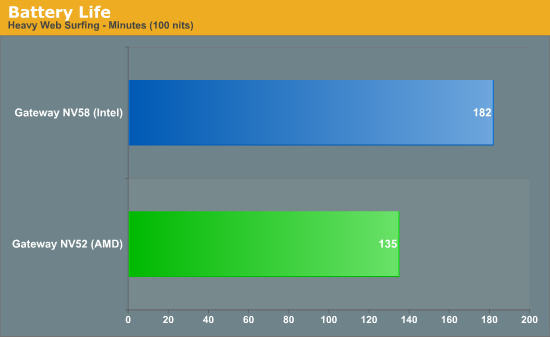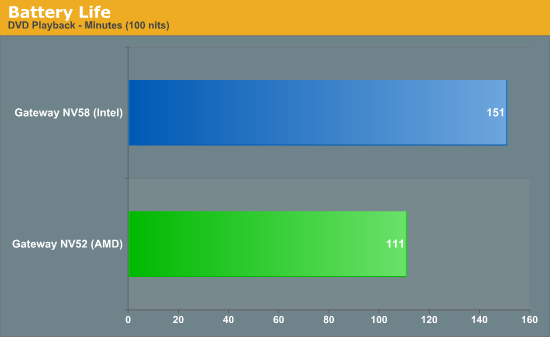AMD vs. Intel: Battery Life Investigated
by Jarred Walton on August 5, 2009 5:00 PM EST- Posted in
- Laptops
AMD vs. Intel: Battery Life Investigated
Both laptops used identical power saving settings under Windows Vista's "Balanced" plan (with some minor tweaks to the defaults on both systems). We ran five different test scenarios, ranging from best-case idle battery life at the Windows desktop to a far more taxing DVD/x264 playback results, along with two different Internet surfing benchmarks. One Internet benchmark represents a "light" load while the other has far more Flash content and represents a "heavy" load. We set both LCDs to 100 nits brightness (40% in this case) and completed a couple charge/discharge cycles to break in the battery before beginning our tests. Here are the results.





Considering these systems are as close as we can get to "identical", AMD takes a real pounding in battery life testing. The closest result (the idle test) has the Intel platform providing 20% more battery life, while the best Intel results (DVD playback and heavy web surfing) give about 35% more battery life. Averaging all five results, the Intel-based NV58 delivered 28% more battery life than the AMD-based NV52. Ouch.
Obviously, despite having identical clock speeds there are some real differences between the two processors. For one, Intel's T6500 is a 45nm part compared to the 65nm QL-64 (not that AMD has 45nm parts yet). We also don't know how much of an impact the various chipset and motherboard components might have. What we do know is that AMD's current mobile processor lineup consists of dual-core CPUs that range from 2.00GHz up to 2.50GHz, with most having a 31W TDP to 35W TDP rating; the TK-42 is a 20W 1.60GHz part and the QL-62 is a 25W 2.00GHz part. Intel on the other hand has many more options. 10W dual-core CPUs are available with clock speeds of 1.06GHz to 1.60GHz; 17W chips have clock speeds ranging from 1.33GHz to 2.13GHz; 25W processors start at 2.26GHz and end at 2.66GHz; and the 34/35W parts cover the gamut from 1.60GHz all the way up to 3.06GHz… and that's just the Core 2 Duo parts! Pentium Dual-Core, Core 2 Quad, and Core 2 Extreme parts are also available to flesh out the spectrum. Then again, some of those parts cost twice as much as the Gateway NV52 just for the CPU.
When Intel released Banias and the Centrino platform in March 2003, they started a revolution in their approach to mobile processor design. Power and efficiency became the focus rather than pure clock speed, and the result has been much better mobile processors when it comes to performance per Watt. Unfortunately for AMD, they appear stuck with the old way of doing things: build a generic architecture and then optimize it for power requirements on mobile chips. Essentially the same core K8 architecture that launched in 2003 continues to power AMD's mobile offerings, and while the ensuing shrink to 65nm has helped there's still a lot of ground to make up. AMD-based laptops are still more than fast enough for most users -- and let's make this clear, a $500 dual-core AMD laptop is tons faster than anything using Intel Atom (though it uses more power, obviously) -- but Intel has the upper hand. It's unfortunate there's not more competition in the mobile processor space, or we might start really start to see prices drop!
For now, if you're looking for an inexpensive laptop (not a netbook), you need reasonable battery life, and you don't care about graphics performance we suggest saving up the extra $50-$100 for an Intel-based system.










80 Comments
View All Comments
sublifer - Thursday, August 6, 2009 - link
Don't know how I missed those posts... I thought I read through them all to make sure my concern wasn't already raised.Apologies
mmatis - Thursday, August 6, 2009 - link
You say:"For now, if you're looking for an inexpensive laptop (not a netbook), you need reasonable battery life, and you don't care about graphics performance we suggest saving up the extra $50-$100 for an Intel-based system."
Why not take the "extra $50-$100" and buy a spare battery or a larger battery? THEN which one has the longer battery life?
lyeoh - Friday, August 7, 2009 - link
For some reason spare batteries cost a lot nowadays at least when someone I know was buying a laptop AND wanted a spare battery. The spare battery cost more than USD250.A retailer for a different laptop said its spare batteries were about USD140, but when we checked they didn't have any in stock (none in the entire country either), and we would have to order and wait for weeks.
jamawass - Thursday, August 6, 2009 - link
These low cost laptops aren't really designed for much portability so battery life is a moot point. I was shopping around for a sub $700 machine and decided on AMD, the reason: virtualization support, I plan on upgrading to Win 7 professional with xp mode. I couldn't find a single Intel cpu in that price range that supported virtualization.drmo - Thursday, August 6, 2009 - link
I think many people would still want to have enough battery life to watch a DVD at an airport or on a plane for those infrequent trips. The buy a bigger battery for the extra $50-100 is a very valid point though. And when I go on trips I like to be able to do some light gaming as well, and having to pay the extra $100-200 for discrete graphics which kill the battery life at other times (unless it can switch off) is not worth it.I'm curious as to why the AMD system sucked so bad to payback DVDs. This seriously sounds like a driver issue. I mean, was the CPU at 100%? Shouldn't it be offloaded to the decoder? Or does the decoder suck more juice??? I really think the full review should look into this.
This was a great teaser for the full review.
JarredWalton - Thursday, August 6, 2009 - link
The DVD playback is likely caused by the AMD CPU not power saving as well as the Intel when under a light load (maybe 5-10% CPU usage). Also, Cool 'n Quiet does not do AMD any favors in single-threaded tasks. I'm not sure if there's more to the DVD playback issue than that, but the results are relatively consistent with the other "heavy surfing" test (which is actually about the same 5~10% CPU load).drmo - Thursday, August 6, 2009 - link
"The DVD playback is likely caused by the AMD CPU not power saving as well as the Intel when under a light load (maybe 5-10% CPU usage). "I think you are right, but if this is a function of architecture, then that AMD should fix it; I mean, why have 100% power consumption if only 10% of CPU cycles are being used?
I guess the number makes sense compared to x264 test because the DVD-ROM is also using energy in the DVD test. I suppose having a file on the hard drive is better than playing off the DVD-- another reason arguing for legal digital copies.
monomer - Thursday, August 6, 2009 - link
If this section is going in the full-blown review, would it be possible to add in some CPU usage charts to go along with the battery life charts? It would be interesting to see another data point to show how much the CPU (and indirectly the GPU) affects each of the battery life tests.medi01 - Thursday, August 6, 2009 - link
So we have 2 laptops, and the one with MUCH FASTER GPU eats roughly 30% more power. So what?JarredWalton - Thursday, August 6, 2009 - link
And the other provides a MUCH FASTER CPU along with 25% more battery life. If you don't play modern 3D games at all (and you really shouldn't on any of the IGPs IMO), having a fast GPU is silly. I can't tell you how many people I know that have never run anything more taxing (GPU-wise) than Aero Glass on their computer.